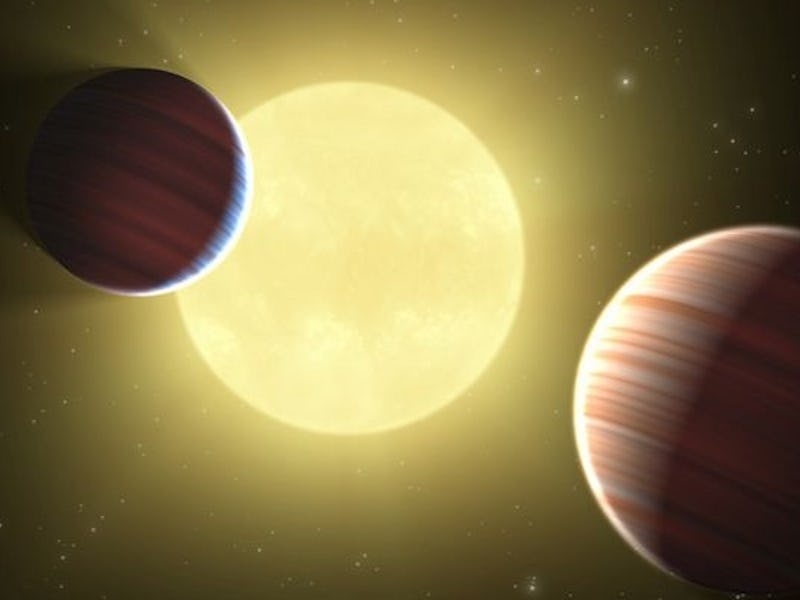Looking for Alien Life on Other Planets? Check the Planet Next Door
All good things come in twos -- including E.T.

The key to finding life on other planets might actually be in narrowing our search to pairs of exoplanets. Why? According to one astrophysicist, there’s a really good chance if life develops on one rock, it will spread to another — whether on purpose or by happenstance.
In a presentation of findings on Tuesday at the Extreme Solar Systems III conference in Waikoloa Beach, Hawaii, Jason Steffen of the University of Nevada, Las Vegas suggests that exoplanet pairs located in distant star systems — with comparable orbits and distances from their host star — would be likely to develop as very similar worlds. If they turn out to be inhabitable and exist in what scientists call the ‘habitable zone’ of a star system (such as where Earth and Mars are located in the solar system), they could both sustain life and in fact help one-another to sustain that same type of life.
The Kepler mission — which has been invaluable in the search for exoplanets over the last several years — has found many planetary bodies comprised of pairs orbiting very close to one-another. Steffen was primarily interested on what they might look like if they were scaled up to the size of the solar system, in which they only resided about one-tenth of an astronomical unit apart, or about 40 times the distance of the Earth from the Moon. (That might seem like a lot, but Mars actually is roughly 200 times the distance of the Earth from the Moon.)
Using data we already have, Steffen decided to run a series of computer simulations of a pair of similarly sized exoplanets just one-tenth of an astronomical unit apart — residing in star systems resembling the solar system — and explore the ramifications on the potential for sustaining alien life on two different fronts.
The first was how close proximities would affect the climates on pairs of planets. And the answer? “The climate would be no worse in these systems than they would in the solar system as we have now,” Steffen said in a news conference today. “You’re no worse off by having a neighboring planet that’s also in the habitable zone.” There wouldn’t be any large changes in the climates of the two planets just because they were now closer together.
Really, there would only be upsides. You could study the other planets’ atmosphere and weather phenomena with greater detail. You could see their clouds the way you can see Earth’s clouds from even far away in space. Most importantly — you could potentially communicate with any intelligent life that lived on that other planet.
But there’s another, bigger implication with having two inhabitable planets close to one-another. It has to do with panspermia — the idea that life from one planet can hitch a ride on a meteor that’s ejected from the surface (probably due to another collision) and be launched towards another planet.
Steffen found that basically, if you have two inhabitable planets that are close to one-another, life-bearing material could quite easily find its way from one world to the other. Just imagine a strong enough collision into the surface could basically take microbes from one planet to the other. The energy required to eject those meteors and deliver them to the other planet would be a lot less with such a short distance. And if they possess a lot of the same conditions for sustaining life, you have yourself a pair of twin planets with the same kind of life.
Even stranger, Steffen found that a series of ejections would could from “streams of [life- bearing] debris [to be] coming off the surface of the planet” and entering the space of the other. Imagine a river of debris flowing from one planet to the next, carrying primitive, single-celled life on it and making its way toward the other planet.
Ultimately, “life in a multi habitable system may have a higher probability of surviving,” says Steffen.
Could life have started like that here on Earth? Possibly, but probably not. The closest estimates we have now suggest Earth is just within the solar system’s habitable zone, as is Mars. Maybe life from Mars found its way over here via meteor. But the distance is so large, and Mars has so few of the characteristics we typically think about for fostering life, that it’s a pretty remote possibility. The odds that life here on Earth has found its way to Mars is even lower.
Although the study is purely theoretical, it does raise high hopes for the idea that exoplanet pairs that are potentially habitable could be feeding life to one-another as we speak. It’s just a matter of finally finding where E.T. has been hiding all this time.